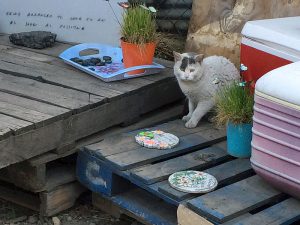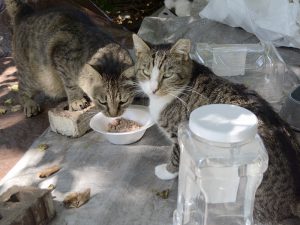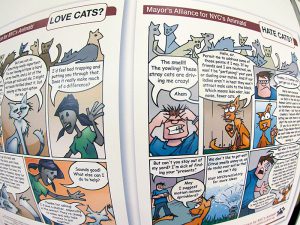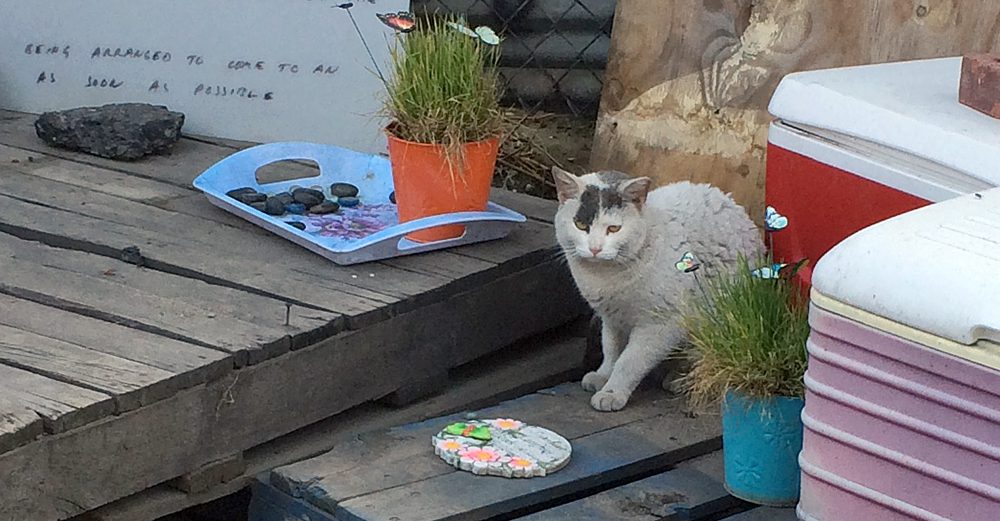
As the NYCFCI’s Director of Education, Kathleen O’Malley states, “The basic rule of thumb is that if you are doing everything for your colony by yourself, you are doing too much.” According to the NYCFCI, “You need to create a ‘deep bench’ of helpers,” so that you do not burn out taking care of a colony (or colonies) of cats on your own and so you and the cats are covered for whatever reasons you might need to be away for a day or longer. “In the best case scenario,” says Kathleen, “it takes a village.”
Kathleen points out that there are different roles in caring for community cats, ranging from TNR work to donating food to feeding the cats to ongoing maintenance of colony sites and more. It is important, she says, to recognize your limits and to seek out helpers who live in your community.
The NYCFCI is aware that many caretakers feel as if they have to do everything themselves because they believe that everyone in their communities is against the cats and, as a result, against the cats’ caretakers. Kathleen guarantees that this is not the case. “I wish something in life were 100%,” she says, repeating a statement originally made by long-term Certified TNR Caretaker Sheila Massey, “but nothing is, and luckily, that includes the statement that everyone in my neighborhood hates the cats.”

Following a practice that he credits Sheila with initiating, Mike strongly recommends that you not hide what you are doing, but feed the cats out in the open, unless there is a clear sign of danger to the cats if you do so. This will provide you with an opportunity to create an awareness of and interest in what is happening with the cats.
Sheila recommends that you prepare a concise explanation about what you are doing that you are ready to share with anyone who stops to talk to you. It is important, Sheila cautions, that you weave the information into your casual conversation and not deliver it formally or as an educational lecture. The goal is to get people to realize that by taking care of community cats, you are really providing a benefit to people and to the community.
Shelia, who took care of at least one cat colony in upper Manhattan for six years, has a four-point message that she worked into her friendly exchanges with her neighbors. The main talking points are as follows:
- What I am doing is a program supported by the Mayor’s Alliance for NYC’s Animals.
- We trap cats and get them vaccinated so they are healthy and neutered in order to stop them from breeding.
- Then we put them back and feed them every day so that they will stay put.
- This way, we will not have any rats.
Sheila says you want people to understand that you are not a “crazy cat person,” but that you are part of something larger and working as a “we” for the good of all concerned. She also stresses that you don’t have to convince everyone to like the cats, that the goal is to get people to like and trust you.

Once you’ve identified people who are supportive of your efforts, you should establish an ongoing friendly dialogue and don’t immediately ask for help. First make sure someone is comfortable with the idea of helping out, and then start small. Perhaps ask them to pick up a bag of food for you one day if you’re stuck at work. Gradually work up to asking for what you need help with in an ongoing way. Sheila says it took her about three years of constantly talking to people on her block to get her “deep bench.” Before she left the neighborhood in 2014, she had dedicated colony feeders for six days of the week.
Networking within your community to find help in caring for your cat colony should be ongoing. It is, says Sheila, an essential, if sometimes overlooked part of being a caretaker. “Even when you are tired,” she says, “you still need to be upbeat and friendly.” In addition to talking to people as if they were all allies, Sheila also, early on, put flyers under her neighbors’ doors that explained the benefits of TNR. According to Kathleen, caretakers in Greenpoint, Brooklyn, recently sent a flyer around their community that featured cute photos of the cats in their care, adorned with hearts.
Another way to reach people who might be interested in helping out, suggests Kathleen, is to put up a sign near the cats’ feeding station with a dedicated e-mail address where you can be contacted.

It is obviously easiest, say Mike and Kathleen, to get people to help out once you’ve completed TNR of an entire colony. Then people will have had a chance to see for themselves that the cats are no longer yowling, spraying, fighting, and increasing in numbers, but are, importantly, continuing to control the rat population.
“People like to see good things happening in their communities,” says Shelia. That’s another reason to share success stories, such as the completion of a TNR project with your neighbors. Sheila was even able to tell her neighbors that two of her colony’s cats, Mr. McGee and Sampson, were going to appear in an episode of Animal Planet’s TV series Must Love Cats about working cats in NYC. The cats reportedly remained unaffected by their brush with fame, but the national publicity was undoubtedly a great networking boon for community cat caretakers everywhere.


